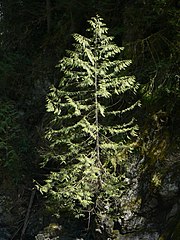Difference between revisions of "Thuja"
| Line 1: | Line 1: | ||
| + | {{SPlantbox | ||
| + | |familia=Cupressaceae | ||
| + | |genus=Thuja | ||
| + | |common_name=Arborvitae, Red Cedar, White cedar | ||
| + | |Temp Metric=°F | ||
| + | |jumpin=If this plant info box on watering; zones; height; etc. is mostly empty you can click on the edit tab and fill in the blanks! | ||
| + | |image=Upload.png | ||
| + | |image_width=240 | ||
| + | }} | ||
__NOTOC__{{Plantbox | __NOTOC__{{Plantbox | ||
| name = ''Thuja'' | | name = ''Thuja'' | ||
Revision as of 19:35, 19 April 2010
|
Thuja > |
If this plant info box on watering; zones; height; etc. is mostly empty you can click on the edit tab and fill in the blanks!
| Origin: | ✈ | ? |
|---|
| Exposure: | ☼ | ?"?" is not in the list (sun, part-sun, shade, unknown) of allowed values for the "Exposure" property. |
|---|---|---|
| Water: | ◍ | ?"?" is not in the list (wet, moist, moderate, dry, less when dormant) of allowed values for the "Water" property. |
|
Thuja > |
Read about Thuja in the Standard Cyclopedia of Horticulture
|
|---|
|
Thuja (Thya or Thyia, an ancient Greek name for a resinous tree or shrub). Also spelled Thuya or Thuia. Including Biota. Pinaceae. Arbor-vitae. Ornamental woody plants, grown for their handsome evergreen foliage and formal habit. Resiniferous trees with short horizontal much ramified branches; the flattened branchlets arranged frond-like: lvs. decussate, scale-like, appressed, usually glandular on the back: fls. monoecious, globose, small, terminal on short branchlets, staminate yellow and consisting of usually 6 opposite stamens each with 2-4 anther-cells; pistillate consisting of 8-12 scales in opposite pairs, of which only the middle ones, or in the section Biota the lower ones, are fertile, each scale with 2 ovules inside at the base: strobiles globose-ovate to oval-oblong, with 2 seeds under the fertile scales.— Five species occur in N. Amer., E. and Cent. Asia. The wood is light and soft, brittle and rather coarse-grained, durable in the soil; it is much used for construction, cabinet-making, and in cooperage. T. occidentalis contains a volatile oil, and thujin and is sometimes used medicinally. The thujas are trees of narrow pyramidal habit, but low and bushy in many of the numerous garden forms, with much ramified branches, the branchlets arranged frond-like, flattened and clothed with small scale-like leaves; the fruit is a small strobile or cone not exceeding 1 inch in length. The well-known T. occidentalis is hardy North; and also T. Standishii, T. plicata, and several forms of T. orientalis are hardy as far north as Massachusetts. Thujas are favorites for formal gardens. They are all of regular symmetrical habit. Their numerous garden forms vary greatly in habit and in color of foliage. For planting as single specimens in parks they are mostly too stiff and formal, but they are well suited for massing on borders of streams or lakes. The most beautiful and the most rapidly growing species is T. plicata. Thujas are well adapted for hedges and windbreaks (see Gn.M.2:15). They bear pruning well and soon form a dense hedge. They thrive best in somewhat moist, loamy soil and are easily transplanted. Propagation is by seeds sown in spring. The varieties, especially those of T. occidentalis, are usually propagated by cuttings taken late in summer and kept during the winter in a cool greenhouse or frame; also by grafting on seedling stock in summer or early in spring in the greenhouse. The varieties of T. plicata and T. orientalis are usually grafted, since they do not grow readily from cuttings, except the juvenile forms of the latter, as var. decussata and var. meldensis. Consult Retinispora. T. dolobrata, Linn.-Thujopsis dolobrata. CH
|
Cultivation
- Do you have cultivation info on this plant? Edit this section!
Propagation
- Do you have propagation info on this plant? Edit this section!
Pests and diseases
- Do you have pest and disease info on this plant? Edit this section!
Species
- 5 Specieswp
- Thuja koraiensis - Korean Thuja
- Thuja occidentalis - Eastern Arborvitae, Northern Whitecedar
- Thuja plicata - Western Redcedar
- Thuja standishii - Japanese Thuja
- Thuja sutchuenensis - Sichuan Thuja
Gallery
If you have a photo of this plant, please upload it! Plus, there may be other photos available for you to add.
References
- Standard Cyclopedia of Horticulture, by L. H. Bailey, MacMillan Co., 1963
External links
- w:Thuja. Some of the material on this page may be from Wikipedia, under the Creative Commons license.
- Thuja QR Code (Size 50, 100, 200, 500)

